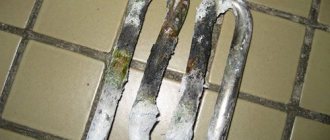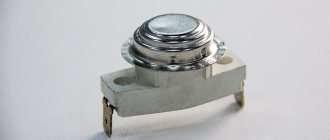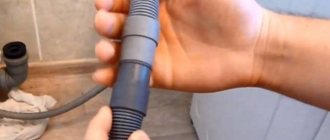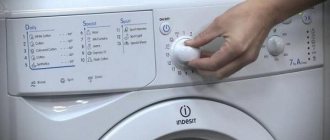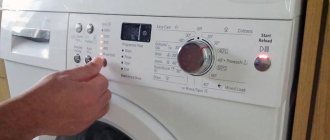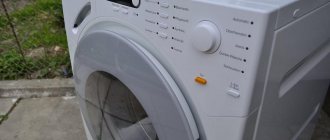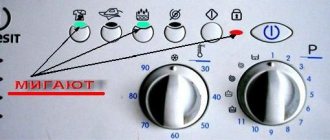Automatic washing machines are usually connected to water supply, sewerage and electricity.
However, they only require cold water, since they heat the water themselves, using a built-in heating element. A heating element is a heating element in a washing machine.
It heats the water to the desired temperature, which is programmed into the machine.
From this article you will learn about what a heating element is and the principle of its operation. You will also learn how to choose the right heating element when purchasing, how to check it and install it in its place.
What is the heating element of a washing machine? Location of the heating element in washing machines
Before disassembling the washing machine to get the heater, you need to determine where the heater is located in the washing machine.
It's not difficult - you just need to look at the back of the car and see how big the back cover is. If it is large, covering the entire wall, then most likely the heating element is located right behind it. Usually down under the washing tub.
In this case, removing the heating element is quite simple, since you just have to unscrew the back wall.
If the cover is small, then most likely it is a hatch to provide access to the machine belt. In this case, the heating element should be looked for at the front of the machine, behind the front panel. Disassembling it takes much longer and is more difficult than removing the back cover.
In any case, it is recommended to start by removing the back wall of the machine to understand where exactly the heater is located in this model. Moreover, it is completely easy.
If the instructions for the washing machine have not been preserved, then you can also be guided by the fact that for washing machines of the brands Zanussi (Zanussi), Kandy, Electrolux, Ariston, Indesit (Indesit), Virpul, Atlant, Beko (Veko), the heating element is usually located behind the back lid.
In Hans brand machines, in order to get the heating element, you need to remove the base panel. For this brand and for most machines that have a vertical principle of loading laundry, the heater is located on the side.
In washing machines of the Siemens, Samsung, Bosch, LG brands, in order to replace the heater, you will almost certainly have to remove the front decorative panel.
Before removing the heating element, it is necessary to drain the water from the machine, so you should prepare a rag and a container to collect the liquid in advance.
The algorithm for removing the heater is as follows:
- The wires leading to it are disconnected;
- The nut located in the middle of the heater is unscrewed;
- The threaded pin is pushed in - press it or hit it with a hammer (not too hard).
After this, by picking up the element with a knife or screwdriver, you can remove it. Sometimes this requires rocking it from side to side if the part is stuck.
Dismantling electrical contacts and heating elements
In most cases, the heating element is located under the tank. It looks (or rather, the part with contacts) like an oval block with three contacts and a nut in the middle. The last one is fastening the heating element through the sealing collar.
Before dismantling the heating element, remove the terminals from the contacts, remembering which one was located. Disconnect the ground wire terminal in the center, as well as, by bending the clip in the connector, the block with the temperature sensor wires.
Now it's up to the central nut. Carefully unscrew it, without removing it completely, and press inward. This is necessary so that the rubber cuff compressed inside decreases in profile and ensures free exit of the heater from the installation socket of the washing tank. To push the nut with the stud inside, you may need to tap it with a hammer through some piece of wood so as not to spoil the thread.
After the pin is pushed in, carefully remove the heater from the tank socket. Because The edges of the heating element flange are sharp; it is worth protecting your fingers with gloves in advance. The pulling forces can be quite large and it may be necessary to pry off the sealing rubber with a screwdriver. In this you should be careful and patient, without using excessive force and without damaging the tank and heating element with tools.
Once the element is finally completely removed, the moment of truth comes - the heating element may be in good condition with a clean surface, which indicates high-quality detergents and not hard water. Or there will be a deposit of scale on it, which you will have to get rid of by placing the working part of the tube in a basin with anti-scale. After cleaning the surface of the heater tubes, wipe them dry and remove any contamination from the rubber seal. Now it is like new and can be used again.
If you already guessed that the heater is out of order and have already bought a spare one (usually the heating element is suitable for different models of machines and costs from 600 to 800 rubles), simply replace it by installing it in its original place.
To complete the repair and maintenance, perform all operations in reverse order, tightening the seal nut, screwing the contacts and connecting the ground terminal. Install the cover and screw it in place.
If you encounter other problems with your washing machine, this workshop will allow you to fix other items. For example, you can easily replace a worn drive belt. Or, if the machine does not start, the reason is probably due to worn-out carbons of the electric motor rotor contacts (two rectangular rods on copper wires with springs).
You can easily determine this if you remove them from a special compartment on the machine engine and measure the size of the rods. It should not be less than permissible for a given model of the unit.
- How to fix an LED light bulb yourself: step-by-step instructions
- How to fix headphones yourself: step-by-step guide
- How to repair a smartphone and tablet with your own hands: basic repair details
Photo: manufacturing companies, Andrey Kireev
What is a dry heating element for a water heater? “Dry” heating element - design and features
The heating element of such a heating element is also a nichrome spiral. But it is not inserted into the tube and is insulated not with filler, but with ceramic insulators.
Dry heater appearance
Individually, its elements look like this:
Individual elements of a “dry” heating element
It is clear from the drawings that such a device cannot be immersed in water. It is not intended for contact with water, hence the name “dry”. The assembled heater is installed in a special flask made of metal or heat-conducting ceramics. The surface of the metal flasks is coated with anti-corrosion enamel.
"Dry" heater in a flask
And the flask itself is built into a heated container and insulated with gaskets. Unlike the wet version, both the flask and the heater itself are always made in a straight shape, without any bends. And the “dry” heating element is installed in the water heater only in the lower part of the tank.
Dry installation of a heater in a boiler
The fact that the heating element itself does not come into contact with the inner surface of the installation flask limits the rate of initial heating of the water. And although the gaps between the heating element itself and the wall of the flask are minimal, some time is still spent warming up the air gap. For this reason, current dry-type designs are not installed in instantaneous water heaters, and they are used only in storage water heating systems.
TEN, what is it? Tubular electric heater
A tubular electric heater (TEH) is an electric heating device in the form of a metal tube filled with a heat-conducting electrical insulator. A conductive thread (usually nichrome or fechral) of a certain resistance passes precisely through the center of the insulator to transfer the required specific power to the surface of the heating element.
It is used in many household and industrial electrical appliances: kettles, boilers, washing machines, water heating and heating boilers, etc.
The PETN was invented and patented on September 20, 1859 by George B. Simpson in Washington, DC.
Double-ended heating element of an electric stove in the form of a spiral. Power regulation with a rheostatic switch or cyclic on-off over time
A single-end heating element of an electric stove in the form of a spiral with three heating threads of different resistance connected at the blind end of the heating element. Power regulation by combining current supply to the terminals with a switch (1 ~ 2 0; 1~30; 2~30; 1~2~30)
Tubular electric heaters can have different diameters ranging from 6 to 24 mm. Depending on the specific application (heating liquid or air), in the production of heating elements, electrical insulators (dielectrics) of various qualities are used, which must retain their dielectric properties at low, high and extremely high temperatures.
According to their configuration, heating elements are divided into double-ended (when the contact terminals are located on both sides) and single-ended (“cartridge”) - with contact terminals located on one side of the heater. Electric boilers usually contain blocks of heating elements, or, as they are also called, “TENB”.
Heating element for a washing machine, what is it. How to choose a heating element for a washing machine
How to choose a heating element (heating element) for a washing machine according to the brand of equipment.
Seat
The most important thing when selecting a heating element is that the seat fits. Almost all heating elements have the same place. The exception is heating elements on old washing machines that are more than 12 - 13 years old.
Presence of a collar
The presence of a collar must be taken into account. If instead of a heating element that did not have a collar, you put a heating element with a collar, then this heating element may fly out of the tank during washing. In principle, it is possible to install a heating element without a collar in place of a heating element with a collar, but it is not advisable.
Hole for sensor
Some heating elements have a special hole for the sensor. On all heating elements that come with a sensor, this sensor can always be pulled out, even if it seems that it is sealed. Instead of a heating element without a hole, you can install a heating element with a hole using a special plug. There are models on LG washing machines that have heating elements with a sensor, but nothing is connected to the sensor. In this case, you can install a heating element without a hole.
Heating element length
After that there is a difference in length. Heating elements are short, medium and long. It is advisable to take the length into account, but if the new heating element is a little longer or shorter than the old one, then it’s okay. You can also install a short heating element instead of a long one, but a long heating element will not fit in place of a short one (it may not fit).
Heating element power
Next comes power. Power doesn't matter. If the heating element is more powerful, then it will heat the water a little faster, and if it is less powerful, then it will heat the water a little longer. The difference will not be noticeable.
Heating element shape
Another point is the shape of the heating element. Almost all heating elements are straight, but sometimes curved ones are found. This must also be taken into account.
Heating element coating
Some models of washing machines are equipped with heating elements with ceramic or other coatings. It is not of fundamental importance; it may last a little longer.
Manufacturers of heating elements
- Thermowatt (the best in quality, these heating elements are stamped “made in Italy”)
- IRCA (second in quality, but these heating elements come with a fuse)
- Blackmann (worse heating elements, very rare)
The manufacturer does not matter, the main thing is that the heating element fits other parameters.
Brand selection process
- Samsung, Indesit, Ariston - short heating elements with a hole, without a collar. Some Samsungs have ceramic heating elements. Instead of them, you can install ordinary short heating elements with a hole.
- LG – short heating elements without holes. Some models come with heating elements with sensors.
- Bosch, Siemens - medium heating elements with a collar and a hole.
- Candy – long heating elements without a hole, with a collar.
- Electrolux, Zanussi - long heating elements with a hole, with a collar.
- Ardo - sometimes there are curved heating elements with or without a hole.
- Older models of the brands listed above may have other heating elements. Basically, long heating elements were installed in the past. There may or may not be a hole for the sensor.
This list is indicative only. Discrepancies are possible!
Signs that the heating element has burned out
- The washing machine does not heat the water
- The washing machine fills with water and stops or turns off after 5 minutes
- 5 minutes after the washing machine starts working, the plugs break out
- The smell of burning
- The washing machine does not wash well
- The washing machine is electrocuted
In our catalog of spare parts for washing machines, you can select the appropriate heating element for your washing machine based on the brand or size of the heating element. You can order a spare part on our website, or by calling.
Standards according to GOST
SMA is a household appliance that must comply with certain rules and standards in force in the country.
In accordance with the standards (GOST 8051-83), the average service life of the SMA should not be less than fifteen years or seven hundred hours of operation. That's quite a lot! But this is according to Soviet-era documentation.
Not all washing machine manufacturers offer such durable equipment for sale. Most units do not meet the deadlines established by GOST and break down prematurely. There are a lot of reasons for this. Let's take a closer look at the main ones.
What is a heating element in a washing machine? Heating element for washing machine
Among the main elements of a household washing machine, a special role is given to the heating element. If it fails, the equipment stops working properly. The malfunction of this element is the main reason for contacting the repair service.
What is a heating element in a washing machine, the main function
A tubular electric heater is a tube with a spiral inside, which consists of a heat-conducting insulator and a conductive thread. The curved tube of the heating element is attached at both ends to the flange. A special gasket on the flange allows for a tight installation when tightening the nut. In order to securely fix the heating element, it is necessary to perform the installation correctly.
The main function of the heating element is to heat water to a certain temperature set by the washing mode.
Failure of the tubular electric heater is the main cause of errors or program freezes. If the washing machine does not heat the water, then the heating element is most likely to blame.
The service life of an important element is influenced by many factors:
- part quality;
- hardness of water;
- washing temperature.
- The heating element often breaks due to the formation of a thick layer of scale on it.
Modern types of heating elements
Different heating elements differ from each other in the following parameters:
- length;
- bending;
- power;
- terminals;
- the presence or absence of a hole made specifically for the sensor;
- brand;
- for which tanks (plastic or iron).
1. The length of the heating element can be different. There are short models on the market (15 - 16 cm), medium (17 - 19 cm) or long (20 - 30 cm).
2. The power of the part varies from 1,600 to 2,200 W. Here heating elements can also be short (1,600 – 1,800 W) and long (1,800 – 2,000 W). The power determines how quickly the machine will heat up.
3. According to their bending, heating elements are divided into spiral and curved. It is necessary to take into account the amount of bending in degrees: 15, 30, 45 and more.
4. There is a hole for the sensor on the heating element at the base of the heating element. This element can only be replaced with a part with a hole. If it is not in the heating element, then a similar model is purchased.
5. Intended use for a tank made of a certain material means that you can determine the appropriate heating element for a particular washing machine based on the length of the elastic band that is needed to attach the heating element. If its size is 1.5 cm or less, then it is perfect for an iron tank. If the elastic band in the model exceeds 1.5 cm, then it is used for plastic tanks.
6. The brand that produced the heating element must be taken into account. For washing machines from Europe (Austria, Germany, Italy), it is recommended to purchase heating elements from European manufacturers. If the part was manufactured in Asia, then it is better to consult your sales manager. So, for a German BOSCH washing machine, the best solution is a BOSCH TEN!
How to clean the heating element in a washing machine yourself
Timely cleaning of the washing machine will help maintain its performance for a long time. The insidious scale can cause enormous harm. It is formed when the heating element heats the water. Potassium and magnesium salts break down, forming carbon dioxide and a precipitate called scale.
Today there are washing powders on sale that soften hard water and improve its quality: they contain acid. During the washing process, it can dissolve scale, so when choosing the right product, you don’t have to worry about the cleanliness of your household appliance.
Owners of washing machines who previously did not know about special powders and did not use them can take advantage of the opportunity to clean the heating element with citric acid. To do this, you will need to perform a series of sequential actions:
- 200 g of citric acid is poured into the laundry tank.
- The main wash program is set at maximum temperature.
- The washing machine turns on.
While household appliances are running, the acid cleans not only the heating element, but also the inner surface of the drum and tank. The housewife can make cleaning more effective if she adds an additional 200 g of bleach. This procedure will return the washing machine to its original condition. The owner of Zanussi equipment will never face the problem of washed clothes. Cleaning should be done every 2 months. However, there are also disadvantages here. When citric acid is used constantly, it can destroy not only limescale, but also rubber parts.
Other common problems include leaking drain hoses. Only replacing the faulty element will help eliminate the leak. Before you make a purchase, you need to study the advantages and disadvantages of different models of drain pumps. After analyzing all the possible offers, the owner of the washing machine will make the best choice.
Other significant factors
How many years an automatic machine lasts depends not only on the manufacturer, but also on other factors. Even the most expensive branded SMAs sometimes unexpectedly fail and break down.
The period of uninterrupted operation of the unit depends on:
- Build quality , main components, parts and components. Well-known manufacturers value their reputation and pay due attention to quality, using only original parts.
Electric motors operate the longest in modern automatic machines. Pumps, shock absorbers, heating elements fail much faster.
Some unscrupulous manufacturers deliberately assemble cars from non-original, low-quality parts. The cost of such SMAs is reduced. This attracts buyers. However, poor quality causes breakdowns. As a result, the consumer is forced to frequently replace broken equipment with new ones. The manufacturer is happy with constantly growing sales and sees no reason to improve quality.
Good example. On sale you can find washing machines of the Bosch or Siemens brand, assembled in Russia or China. They are inexpensive. However, when buying equipment at a very attractive price, you should not count on the notorious German quality. In times of crisis, more and more buyers are paying attention to the price rather than the quality of the equipment itself.
- Operating conditions . The more often the device is used, the faster it will exhaust its resource. Hard water has a negative effect on service life. Do you save on special softeners? Be prepared for an early breakdown of the heating element. Foreign objects accidentally left in pockets can also damage the device. The lack of grounding and a protective relay against voltage surges in the network is fraught with burnout of many parts and expensive repairs.
Sometimes machines can handle high voltage without problems. Some models are susceptible to voltage surges and break down already at 230 V.
- Regularity of prevention . Periodic preventative maintenance (replacing filters, cleaning heating elements from scale, etc.) extends the trouble-free operation of equipment. If you carry them out from time to time, the machine is unlikely to work for the period stated by the manufacturer.
Dry heating element water heater, what is it. Features of water heaters with wet heating elements
This type of heating part is one of the most popular and widespread. The wet heating element works directly with liquids. Direct interaction can negatively affect the part itself. Unlike the dry type, scale marks appear faster on the wet type and metal corrosion will occur. They include the following elements in their design:
- Metal tube
- Spiral
- Dielectric filler (it prevents electrical overvoltage)
Despite the fact that boilers have their negative sides, the quality of heating in mechanisms with a wet heating element does not change. In addition, they have other positive qualities, such as price. An open type device will cost several times less than a closed one. Additional equipment for the mechanism also costs less. A good example of this type of heaters is the products of THERMEX. If problems arise, a specially built-in tube will help drain all the water to begin repair work.
Tip: Any heating element will work with such devices; you won’t have to look for a part for a specific model.
Why did we call the master?
I looked on the Internet: prices for this heating element ranged from 400 to 900 rubles. Then I found replacement instructions. It doesn't seem complicated. I also thought that even if it is not a heating element, replacing it with a new one would not be superfluous.
But then the wife, impressed by the broken plugs and scary phrases like “short circuit,” began to insist on calling a repairman. So she told me: “Let a professional do the diagnostics and repairs.” I found a specialist on some website with a lot of positive reviews. We called, we are waiting.
I forgot to clarify that despite the fact that diagnostics are free for everyone, this is not entirely true. It is free only for repairs. If you refuse, you must pay 500 rubles. for the challenge.
The master came in and asked: “What happened?” After our story about the traffic jams, I glanced briefly at the “patient” and immediately gave a diagnosis: “We need to change the heating element or, if you don’t want to, pay 500 rubles. and I went." Cool, you can’t say anything - 500 rubles. per minute of work.
I was ready to pay for the diagnosis only if he proved his “diagnosis”. He had to disassemble the machine. This is really easy to do. Having unscrewed the heating element, he solemnly presented it to us. The element was indeed burnt.
What is a heating element in an oven? Communicate with ovens in the same language
When a housewife gets acquainted with a new oven, the first thing she encounters is the need for translation.
And not in the sense from one language to another, but more often from the names inherent in each company to generally accepted terms. What is it for? It's simple, you can compare one oven with another only when the object of comparison is clear. Therefore, we avoid pretentious, and most importantly, incomprehensible expressions such as “turbo air”, “maxi-grill”, “intense hot air”, “thermal circulation” or “3-0 convection”. And if the description includes some function like “slow baking” or “gratin”, we strive to “shake” the whole truth from the brand department about how it works.
Therefore, the technical characteristics in manufacturers’ catalogs look much brighter and more seductive than our boring, but understandable data. We will not deviate from this rule now, so we assign the same names to the modes that you will see on the following pages of the review.
Don't forget to reheat
At the beginning of the story - some general advice. In the instructions for ovens (which we actively use), for successful cooking, it is recommended to preheat them to the required temperature (we focus on the thermostat indicator lamp; it should go out).
Only for very fatty meat can you make an exception and put it in a cold oven. In this case, the cabinet can be turned off a few minutes before it is ready; the residual temperature will be sufficient for the successful completion of the process. It is advisable to open the door as little as possible, and observe the “behavior” of the products through the glass (this is why the backlight often does not turn off while cooking is in progress).
What is a heating element? Advantages of heating elements
Compared to other types of heaters, heating elements have many advantages.
For example, they can also be used when there is direct contact of the heater with the heated medium. And, as you know, these can be a wide variety of options, not just liquid and gaseous. The medium can even be solid, and the pressure in it can reach up to 4.5 atm. And this will not become an obstacle for the heating element. The advantage of tubular electric heaters is their reliable operation during vibrations, as well as when there are significant shock loads. In addition, they have different configurations. And there is no voltage on the shell of the heating elements.
There is such an important indicator as mean time to failure. When using heating elements to heat air media, it is at least 10 thousand hours. When used to heat liquid media – at least 5 thousand hours.
A double-ended round heating element has a design where the heating element is located inside a metal shell. This is, for example, a spiral or several spirals made of a high-resistance alloy. There are also contact rods there.
The compressed electrical insulating filler serves as an insulator between the shell and the heating element. In order to prevent moisture from entering from the environment, the ends of the heating elements are sealed. There are also dielectric insulators between the contact rods and the shell.
Self-repair instructions
The procedure for replacing the heating element of a washing machine is as follows:
First determine which side the heater is located on. Move the body away from the wall and turn it towards you. If the back cover is large, most likely the heating element is squeezed under the tank from the back side. There will be less work here. If the lid is medium in size, through it you can only get to the washing machine belt, and the heating element is clearly located below, but in front. You will have to completely disassemble the front panel, which will take more time than in the first case.
Having determined the position of the heater, it’s time to move on to disassembling the housing (you can see instructions for disassembling washing machines of different brands here). First, unplug the device to avoid electric shock. If the heating element is located at the rear, disconnect the water supply, drain hose, drain the remaining water from the machine (this can be done by lowering the drain pipe below the level of the device body or using a special drain filter).
Then there are 2 options: If the heating element is behind the back cover, remove it. If it is behind the front, remove the lid from above, pull out the tray into which detergents are poured (it is attached with self-tapping screws and secured with a latch
Carefully disconnect it too). Pull the steel hoop off the seal. It is held by a spring - stretch it a little
Next, remove the seal, door blocker (disconnect the wires from the blocker), remove the front panel
It is held by a spring - stretch it a little. Next, remove the seal, the door blocker (disconnect the wires from the blocker), and remove the front panel.
The next step is replacing the heating element. It is held in place by only one nut, but before unscrewing it, disconnect the power terminals, wires from the temperature sensor, and grounding. To unscrew the nut, take a socket wrench (if you don’t have one, take an open-end wrench).
Unscrew the nut slightly (not all the way, but to the length of the thread), then, pressing the pin inward (this will allow you to pull the part out of the seat), unscrew the nut completely. Use a screwdriver to pry the heating element around the perimeter and slowly tear it away from the rubber. This is done with loosening movements.
Check its functionality. When you go shopping for a new heater, take your old one with you. This will allow you not to make a mistake when choosing a new one, because different heating elements are produced for each model. The part may differ by literally a few centimeters or even millimeters. This is done in order to assign a new series to a line of devices and sell them at a new, higher price. And heating elements are no longer interchangeable. Over time, the installation site becomes covered with a layer of calcium and carbon deposits, so it must be cleaned before work. Do not ignore the tank (how to repair a washing machine tank with your own hands?). Help yourself with a flashlight. Loosen the nut and insert the new heater into place. Tighten and connect all wires. Carry out a test: pour a little water into the tank, turn on the heat for a few seconds. After turning it off, touch the heating element. If it is warm and there are no water leaks, screw on the remaining parts.
Heating element with thermostat. A heating element with a thermostat will heat the water safely and quickly
Heating elements with a built-in thermostat are found almost everywhere where water heating is needed, from factory boilers to homemade convectors made from a cast iron radiator. What advantages and disadvantages does this device have? Let's figure it out.
How it works and how to choose
A heating element with a built-in thermostat has a simple structure, consisting of two parts, a heating element and a temperature sensor connected to a temperature controller. But even here there are several features that significantly affect the serviceability and service life of the device.
- The first thing you should look at when buying is its body. A more durable heating element will be made of copper and have a corresponding noble color; a cheaper option is usually made of “acid-resistant stainless steel”. There is no way to verify how durable this stainless steel really is in the store, so give preference to the brass version of the case. The outer diameter of the tube is usually 13 mm, but there are also thin, low-power options - 10 and even 8 mm;
The steel body of the heating element with a thermostat is usually a little cheaper
The copper heating element body gives more hope for long-term operation - Marking.
Since we are considering a heating element for a water heater, you should make sure that in the marking, before the designation of the operating voltage 220V, there is the letter “P”, indicating operation in water and weak alkaline solutions; Symbols on the heating element body - Power. It should be taken into account that when connecting to a regular home network, you should not use a heating element more powerful than 2.5 kW - this puts too much load on the regular wiring. If you plan to connect a more powerful heating element with a thermostat, lay a separate cable from the panel with the appropriate cross-section to the installation site.
- The temperature sensor is located in a separate tube and, if necessary, is removed from it along with the thermostat. Svidu is a rod. It contains a thermocouple inside, which, when heated, activates the thermostat mechanism. Often, the failure of the temperature sensor causes the heating element to turn off at low temperatures.
How to replace with a new one?
Algorithm of actions:
we clean the seat for the new heating element from debris, scale and washing powder residues; we place a new heating element - it is important to ensure that the new element stands level, stable, without displacement or tilting; in some models of Indesit washing machines, the seat has a guide (looks like a bracket or pin) that does not allow the heating element to move; if there is a guide, you need to get into it, if not, position the heater in the seat as accurately as possible; install a temperature sensor; screw the nut onto the stud - do not tighten the nut too much so as not to squeeze the heating element out of its seat; we connect the wires and terminals to the heating element (we check against pre-taken photos or videos); return it to its original place, fix the back panel.
After the repair is completed, the operation of the heating element must be checked. The best option is to run the wash at a temperature of at least 60°C. If the replacement of the heating element is done efficiently, the sunroof glass will begin to heat up after 10 minutes.
If the heating element is not replaced correctly, error codes will appear on the display during the washing process, the water will not heat up, and leaks are possible.
Video instructions for replacing the heating element in the Indesit washing machine:
